Question:
Which manufacturer
was the first to build their vehicles with air and oil filters;
AND in what
year was this first offered by that
manufacturer?
Correct Answer:
After a full
year of waiting for someone to come up with the correct answer,
we are giving
up and presenting the correct answer for you....
The first vehicle manufacturer to
apply air and oil filters
to their vehicles was
MACK, on their trucks built in
1918.
November
,
December
, January's
Trivia Challenge winner:
Sergio Acosta - San Juan, TX
Question:
Correctly identify
the year, make, and model of the vehicle pictured below.
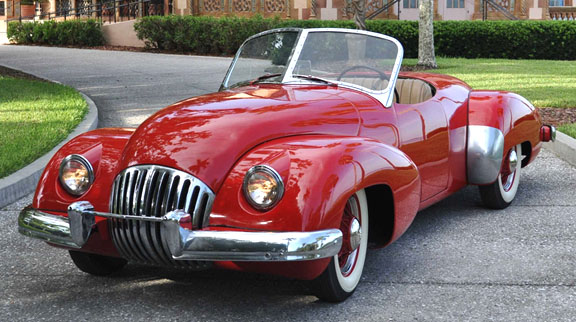
Correct Answer:
The vehicle pictured above is a
1947 Kurtis-Omohundro Comet.
It is
considered to be the first post
World War II American sports car. It was
a coach built aluminum body that
runs on a 1940 Ford frame, with 1946 Ford
chassis components,
including a Ford flathead V8 engine with some of the
earliest ever produced
aluminum Edelbrock heads.
December
, January
, February ,
March
, April
, May
,
June
, July ,
August ,
September ,
October's Trivia Challenge winners:
Guy Tremblay - Quebec City,
Canada
David Redding - Penrose,
CO
Question:
What was the first
production vehicle to offer
an automatically
folding hardtop convertible and in what year was it?
Correct Answer:
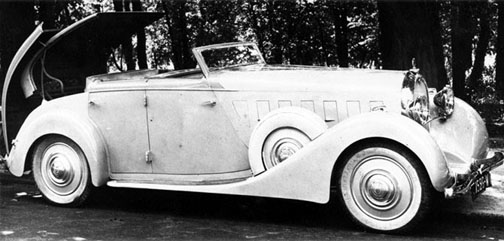
The first documented production
vehicle to offer an automatically folding
hardtop was a
Hotchkiss
in
1933. Georges
Paulin designed the top for coach
builder, Pourtout. Pourtout
put the top on the 1933 Hotchkiss
pictured above.
Later, in 1934, Pourtout would go
on to build several other vehicles with the
same designed top for makes such
as Lancia and Peugeot.
February
, March
, April
, May
, June
, July
, August
,
September
, October
, November's
Trivia Challenge winner:
Erik Andersson - Uppsala ,
Sweden
Question:
Correctly identify
the MAKE of the vehicle pictured below.
What years did
they manufacture these style of vehicles?
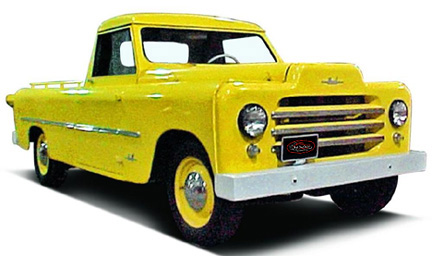
( photo & trivia
question provided by David Redding - thanks David! )
Correct Answer:
The vehicle pictured above is a
Powell Sports Wagon pick up
truck.
Powell produced these style
vehicles from 1954 to
1957. Powell also produced
a similar version of the Sports
Wagon as a station wagon.
September
,
October
,
November
,
December
,
January's
Trivia Challenge winner:
Rose Sterling - Palmhurst,
TX
Question:
Correctly identify
the MAKE of automobile that this badge is from.
What years did
they manufacture automobiles?
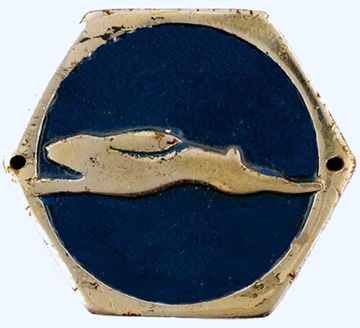
Correct Answer:
The badge is from an Apperson
Jackrabbit which was manufactured by the
Apperson
Brothers Automobile Company. The company was
located in
Kokomo, Indiana and produced cars
from 1902 until
1926. The company was
founded by two brothers, Elmer
Apperson and Edgar Apperson. The two brothers
had previously worked with Elwood
Haynes and helped in the building of one
of America's first ever
automobiles which had been designed by Haynes.
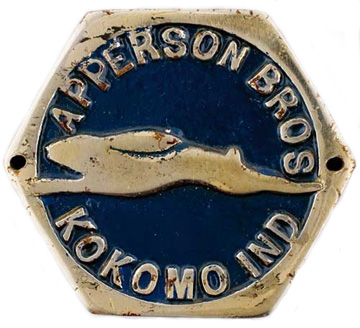
June
,
July
,
August's
Trivia Challenge winner:
David Redding - Penrose, CO
Question:
Correctly identify
the auto manufacturer of the car pictured below,
as well as what
country it was from,
and from what
year to what year the manufacturer produced
automobiles.
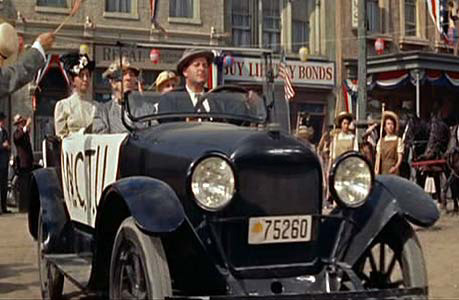
ok, here's a big
hint.....
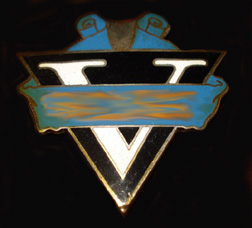
Correct Answer:
The car pictured above is a 1917
Velie touring car. Velie automobiles were
manufactured by the
Velie Motor Vehicle Company
in the good ol'
United
States of America from 1908
to 1928 in Moline, Illinois.
Willard Velie
founded the Velie Carriage Company
in 1902, and after it's success of building
horse drawn carriages, he decided
to try his hand in the automobile business and
so started the Velie Motor Vehicle
Company in 1908. Willard Velie was a grandson
of John Deere of the Deere &
Company, famous for the John Deere tractor.
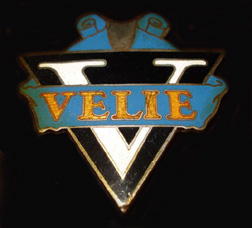
*** BONUS
ROUND ***
Who can name the
movie that the screen grab with the above car pictured is from?
It is the 1955 film,
East of Eden.
January
,
February
,
March
, April
,
May's
Trivia Challenge winner:
Jim Hoffman - where you from
Jim?
Question:
What was the first
auto manufacturer to transport a United States president?
Correct Answer:
The first auto manufacturer to
transport a US president was Studebaker.
The president was Abraham Lincoln
and he had a specially made Studebaker that
he rode in. The Studebaker
that Lincoln rode is was not an automobile,
but rather a specially designed
carriage. The Studebaker company made high-end
horse drawn carriages prior to
building automobiles. In fact, the evening that
Lincoln was assassinated, he rode
to the theatre in a custom built Studebaker carriage.
December's
Trivia Challenge winner:
David Redding - Penrose, CO
Question:
Correctly identify
the year, make, and model of the vehicles pictured below.
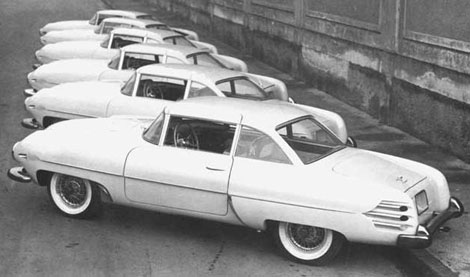
Correct Answer:
The vehicles pictured are
1954 Hudson Italias.
The Hudson Motor Car Company
began manufacturing automobiles in Detroit, in 1909. They
merged with Nash in 1954 to form American Motors. Prior to the
merger,
Hudson, like most other car
companies, wanted to bring attention to their
brand and to bring customers to
the show room. They attempted to do this
by the introduction of the Hudson
Jet. Hudson's chief styling designer, Frank Spring,
had created the original "sports
car" design for the Jet but the company
president, A.E. Barit, and Murray
Body Works drastically changed the
design and created a rather boxy
and awkward designed car that would
become the Jet. Spring was
so upset, that he almost left Hudson over
what had become of his design, but
instead the top officials in the company
gave him an opportunity to design
a sports car type car as he saw fit.
Spring wanted to build a
European-inspired sports car that would rival the
Chevrolet Corvette and the soon to
be released Ford Thunderbird.
This time, Spring worked with
Touring Body Works / Superleggera Carrozzeria
of Milan, Italy to bring his new
design to life. The car would be known as the Italia.
It had a hand formed aluminum body
and initial response to the design by
customers was positive, but by the
time the first 10 cars were built, Hudson
was in such financial trouble that
a merger with Nash soon followed. The new
leaders of the newly formed
American Motors did not want to fund more of
the cars to be built, so it was
decided that for any more of them to be made,
the customer would have to
pay for the car up front before they were to
be built. The cars were very
pricey for the day, about the price of a Cadillac,
however the Italia was still based
on a Hudson Jet chassis and so were
sluggish and did not handle well.
Only 26 Italias were ever produced, all
were painted Italian cream in
color with red and cream interior and equipped
with Borrani wheels.
Interestingly enough, though only 26 of these cars
were ever made, at least 21 of
them still exist in functioning form today.
August
,
September
,
October
,
November's
Trivia Challenge winner:
Richard Staadt - Ft. Wayne, IN
Question:
What is the make
and model of the car pictured below?
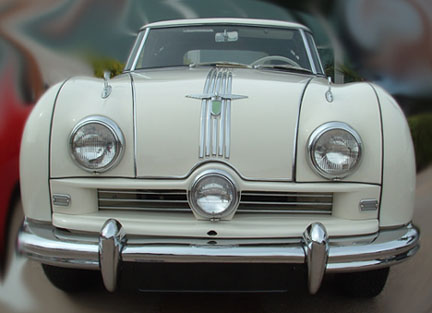
Correct Answer:
The car pictured is a 1950
Austin A90 Atlantic .
January
,
February
,
March
,
April
,
May
, June
, July's Trivia Challenge
winner:
Tom Collins - Ft. Worth, TX
Question:
On what day and
year is it reported that the world's first automobile accident
occurred?
Correct Answer:
There has been a bit of
discrepancy on the correct answer for this one,
and since we
can not find anyone who was alive at this time nor was actually
there when
these events took place, we are having to go to respected
historical
reference sources and trust what they tell us.
Here is
the info that we have:
The very first known
automobile accident in the world occurred in France in 1771,
when Nicolas-Joseph Cugnot lost
control of his steam powered vehicle and ran
into a wall at a speed of 2 miles
per hour.
The first known automobile
accident fatality occurred in 1869 in the countryside
near a small town in County Offaly,
Ireland. Mary Ward was thrown from her
vehicle while driving over rough
terrain and was killed.
The first known automobile
accident in the world involving a gasoline powered
combustion engine vehicle occurred
in Ohio City, Ohio in 1891, when
James Lambert and James Swoveland
lost control of the vehicle they
were driving/riding and hit a tree
root causing the vehicle to careen into
a hitching post. The two
sustained only minor injuries from the accident.
The first officially reported
auto accident in the world occurred on
May 30, 1896
in New York City, New York.
The accident occurred when Henry Wells of
Springfield, Massachusetts
collided into a bicyclist, Evylyn Thomas.
The bicyclist sustained minor
injuries.
( This was the
accident and answer that we were looking for,
as it was the
first officially reported and recorded
automobile accident,
however we
agree that previously known accidents did occur.
The interesting
thing is that a good number of folks responded to this
challenge with
the answer of the accident that occurred in 1891 or the one
in 1896 but
NO ONE responded with the accident of 1771. )
August
,
September
,
October
,
November
,
December's
Trivia Challenge winner:
David Redding - Penrose, CO
Question:
Correctly identify
the vehicle name and manufacturer of the vehicle
that this grille
shell badge is from.
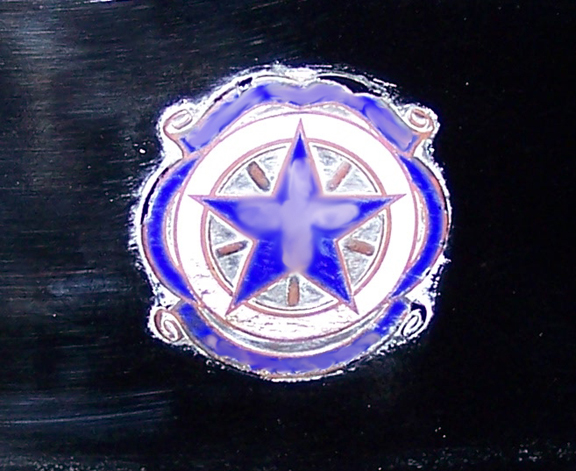
( Please note the
names have been blurred out in the picture. )
Correct Answer:
It is a grille shell badge from a
Texan built by the
Texas Motor Car Association.
The Texas Motor Car Association
was a automobile manufacturer from
Ft. Worth, TX that built vehicles
from 1918 to 1922. Only about 2,000
Texan cars and about 1,000 Texan
trucks were ever built.
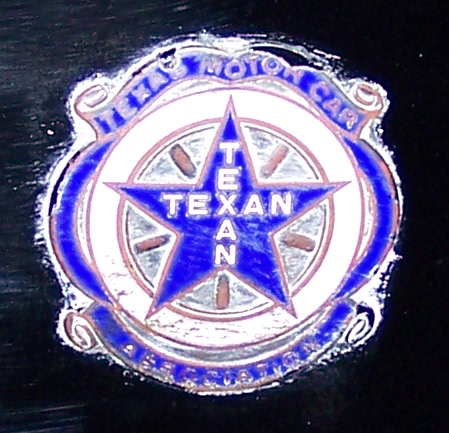
May
,
June
,
July's
Trivia Challenge winner:
Jeremy Johnson - San Marcos, TX
Question:
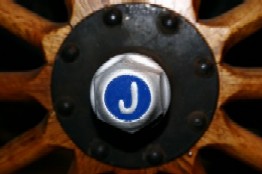
Correctly identify
the vehicle manufacturer that this part is from.
Correct Answer:
It is a hubcap from a Jewett.
Jewett was built by the Paige-Detroit
Motor Car
Company in Detroit, Michigan from 1922 to 1926.
Paige-Detroit also produced the
Paige automobile.
The Paige-Detroit company was sold
to Graham Brothers in 1927
and the Jewett was badged as a
Paige for 1927, then in 1928
the car was rebadged again as a
Graham-Paige.
March
,
April's
Trivia Challenge winner:
James Vazquez - La Feria, TX
Question:
What was the first
American automobile manufacturer to mass produce a
V8 engine and
offer it in its vehicles for sale and what year was it in?
Correct Answer:
Despite popular notions that Ford
was the first American company to
introduce the V8 as they did in
1932, Ford was actually not the first
American company to do so.
In fact several companies built and sold
V8 powered automobiles long before
Ford did in 1932. The first
manufacturer to mass produce a V8
engine and offer it for sale in its
vehicles was
Cadillac. Cadillac introduced its Type 51
engine in 1914 and
it was the standard engine
available in all its cars for the model year 1915.
January
,
February's
Trivia Challenge winner:
David Redding - Penrose, CO
Question:
What was the first
American production car made and in what year was it produced?
Correct Answer:
The first American production car
was a gasoline-powered car made by the
Duryea brothers, Charles and Frank
Duryea, known as the Duryea Motor Wagon
in 1893.
The Duryea brothers were successful bicycle builders who became
interested gasoline-powered
engines and the idea of a self-propelled automobile.
The brothers went on to sell 13
cars by 1896 at which time they created the
Duryea Motor Company which went on
to build and sell cars well into the 1920's.
October
, November
,
December's
Trivia Challenge winner:
Jeremy Johnson - San Marcos, TX
Question:
What American car
company was the first to offer a
vehicle with a
multi-barreled carburetor and what year was it for?
Correct Answer:
It was a
1921 Lincoln.
September's
Trivia Challenge winner:
David Redding - Penrose, CO
Question:
Correctly identify
the year and make of this smashed car?
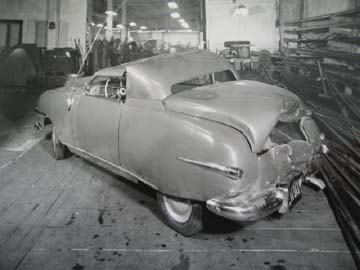
Correct Answer:
It is a
1946 Playboy.
June
, July
, August's Trivia Challenge
winner:
James DeBoard - St. Louis, MO
Question:
What American car
manufacturer first introduced an automatic transmission
on a production
vehicle, and in what year did they do this?
Correct Answer:
Automatic transmissions we first
thought of and developed by inventors
in Germany back in the early
1800's, and not until the early 1900's did some
German manufacturers begin
building and marketing automatic transmissions.
The first applications for the
automatic transmissions was for various marine
engine applications.
General Motors picked up on the
idea and began
developing the idea of the
automatic transmission for automobile applications.
They developed their first test
cars with the automatic transmissions in 1938
and introduced the cars to
the public for sale in 1940
in a line of Oldsmobiles.
The firstl
Oldsmobile automatic
transmission was called a "Hydra-Matic drive."
April
, May's Trivia Challenge
winner:
Christopher Becker -
Wentzville, MO
Question:

The CRAGAR
company is a well known aftermarket manufacturer
of wheels and rims for various cars and applications.
Let's test some
history of the CRAGAR company:
How did the CRAGAR
company get its name?
What year did it
start up as a business?
What was the
company's first product produced with the CRAGAR name on it?
What application
(vehicle)
was this product for?
Correct Answer:
The Cragar company came about when
Crane Gartz, an heir to the
Crane Publishing family joined up
with car racing star Harlan Fengler.
In 1930
they officially formed the Cragar Corporation, Ltd.,
which of course
got its name from the first three letters of the name Crane
Gartz. Long before the company produced their
world famous wheels, they were
involved in a number of other
racing and speed parts. The first
product they produced with he
Cragar name on it was actually an
over-head-valve designed engine head for
Ford Model A 4 cylinder engines.
The original Cragar heads were not
of their own design but rather were
Miller-Goossen head designs that
Cragar had purchased the rights to
along with the tooling, machinery
and patterns for. The company would
go on to produce a large number of
speed parts for various cars and applications.
Under different ownership it would
go on to produce and refine safety
equipment for racing applications
such as the well known Bell helmets.
It was not until 1964 under
another owner that the company would begin
producing wheels when it first
produced its now infamous Cragar S/S wheel.
January
, February
, March's Trivia Challenge
winner:
David Redding - Penrose, CO
Question:
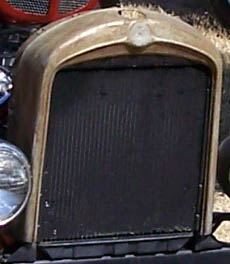
The challenge is
to identify this grille shell.
In the photo, it
is not mounted on the car it was originally made for,
but we want to
know what car it was originally made for.
Can you identify
the correct year, make, model of vehicle that this grille shell
came off of?
Correct Answer:
This grille shell is from a
1926 Hupmobile and was used on a variety of
models.
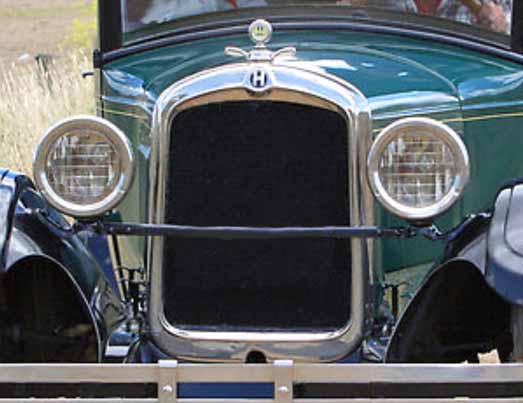
October
, November
, December's Trivia Challenge
winner:
Mike Garrison - Clarendon, TX
Question:
Correctly identify
the year, make, and model of the car pictured below.
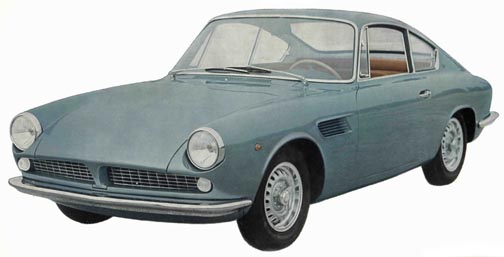
Correct Answer:
The vehicle is a
1963 ASA 1000 Grand Turismo Coupe
Bertone.
August
, September's Trivia Challenge
winner:
David Redding - Penrose, CO
Question:
Correctly identify
the year, make, and model of the car pictured below.
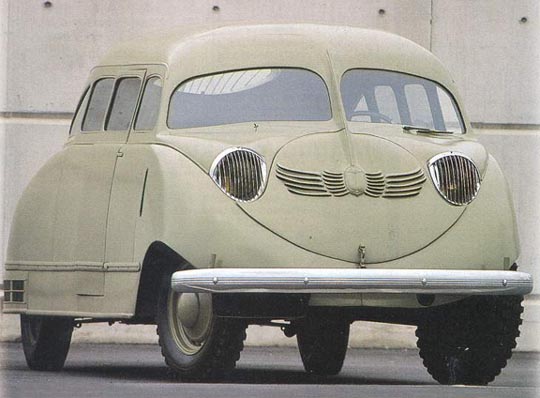
Correct Answer:
The vehicle is a
1936 Stout Scarab.
June
, July's Trivia Challenge
winner:
Trevor Wray - San Benito, TX
Question:
Correctly identify
the year, make, and model of the car pictured below,
and what great
significance it has in automotive history.
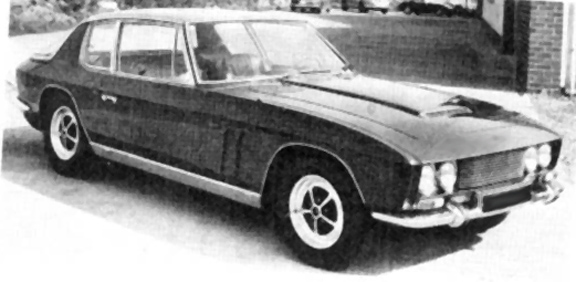
Correct Answer:
The vehicle is a
1966 Jensen FF.
The 1966 model Jensen FF was the
first vehicle to be built with anti-lock brakes.
The car was equipped with a Dunlop
Maxaret electro-mechanical anti-lock
braking system which was
originally developed for use on aircraft.
The 1966 Jensen FF was also the
first production sports car
to be outfitted with a traction
control system and 4 wheel drive.
March
, April
, May's Trivia Challenge winner:
Jeff Stork - Santa Monica, CA
Question:
Correctly identify
the year, make, and model of the car pictured below.
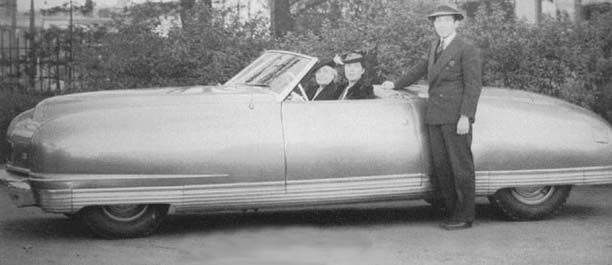
Correct Answer:
The vehicle is a
1941 Chrysler Thunderbolt.
Yes, Chrysler used the Thunderbolt
name long before the 1960's when Ford
produced their 427 powered
performance car under the same name.
November
, December
, January
,
February's Trivia Challenge winner:
Enrique Nieto - Reynosa, Tamps.; Mexico
Question:
What 1978 model
year US made
production vehicle had the fastest 0-100mph time?
Correct Answer:
In 1972, the EPA placed into
effect new regulations on auto manufacturers on exhaust
emissions and forced such things as catalytic converters and gas
mileage constraints thus forcing an end to the muscle car era
that had been growing with leaps and bounds from the late 60's.
By 1975 the car sales on American made vehicles was dropping so
badly due to the loss of horsepower and performance and little
to no gas mileage benefit, that Dodge marketing division
realized that the sales of trucks had not dropped and was
actually growing as the younger generation found that light
trucks would out perform most other cars and they found that
there was a loophole in the federal regulations that they could
produce trucks with high performance equipment still and not be
bothered by the emissions regulations. In 1976 they
released their first truck in a series they named the Adult Toy
Series. The first vehicle introduced was a custom Dodge
van known as the Street Van True Spirit. They also
produced a pickup named the Warlock that year and was met with
such enthusiasm that they continued work on a newer version for
1978 named the Lil' Red Express. The truck was given the
title "The Last Real American Hot Rod" by most of the press and
media and is still considered by many to be the hottest muscle
truck to ever come out of Detroit. The production vehicle in the
United States for the 1978
model year was the Dodge Lil' Red
Express pick up truck. The truck was powered by
a 850cfm four barrel carbureted 360 ci V8 engine with a special
727 automatic transmission. The motor netted 225
horsepower. The truck was available in only one color,
Medium Canyon Red and was equipped with mag wheels, the
trademark Lil' Red Express logos on the doors, real wood panels
on the bed of the truck, and the twin chrome vertical exhaust
stacks just to the rear of the cab. Due to a loophole in
the emissions regulations that year, the trucks were able to be
produced without a catalytic converter, thus being able to just
outperform the Chevrolet Corvette in 0-100mph time. After
Car and Driver Magazine released their statistics on the
performance of the truck, sales jumped to 2,188 for the 1978
model year. The truck was produced in 1978 and again in
1979, however the 1979 models were forced to have a catalytic
converter on their exhaust system, which robbed a good amount of
horsepower. Dodge produced 5,118 trucks for the 1979 model
year but with the drop of horsepower, so did the sales for this
year drop. Dealers had a difficult time selling them so
much so versus the 1978 model year that Dodge decided to cut
their loses and not produce it anymore.
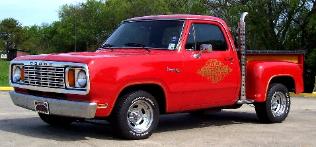
September
, October's Trivia Challenge winner:
Gabe Rios Jr. - Edinburg, TX
Question:
What year did the
recognized Chevrolet bowtie emblem first appear on a car?
Correct Answer:
William Durant was one of
America's leading pioneers and founders of
the automobile industry. He
was the founder of General Motors who from
early on acquired stock control of
Oldsmobile, Pontiac, and Cadillac. He would
later go into a partnership with
Louis Chevrolet to start the Chevrolet Motor
Company in 1911. After a
falling out between the two partners, Durant bought
out Chevrolet's portion of the
company and took over full operation and ownership.
While on a travel around the world
in 1908, he stayed in a hotel in Paris which
had a wallpaper that contained a
pattern with a bowtie type pattern in it. As he
stared at the pattern in his room,
he felt that the pattern would make a great
design for a vehicle badge.
He tore a piece of the wallpaper off and took it with
him as a reference. Years
later he presented the pattern to friends who didn't
show the excitement and enthusiasm
in the idea as he was. He still felt it would
be a good emblem for a car
name badge and in 1913 he
incorporated the bowtie
pattern into the Chevrolet name as
the ID badge on the vehicles. This emblem
has remained a major part of
the Chevrolet vehicle company and is easily
recognizable as representative of
the Chevrolet company and one of the most
successful automotive
companies in this country and the world over.
July
/ August's
Trivia Challenge winner: Petr Lastovicka -
Pecky, Czech Republic
Question:
One vehicle model
sold more than 1 million units in North America
for a single year
model. This sales record still stands today
for a single model
sales count.
What was the year,
make, and model of this car?
Correct Answer:
In 1965,
Chevrolet set an all time
sales record by selling more than one million
Impalas
in North America. The Impala was originally introduced in
1958
and quickly became the best
selling automobile in the United States
throughout the 1960's. The
Impala stood apart from other models in early
years due to subtle but distinct
styling differences including its
trademarked six taillights across
the rear.
April
/ May / June's
Trivia Challenge winner: Ron Gissiner -
Seminole, FL
Question:
The picture below is of a very
significant "first" in automobile history.
What is the
significant "first" that it depicts;
what month, day,
and year was this "first";
what city was this
in;
AND what are the
cross streets shown in this picture?
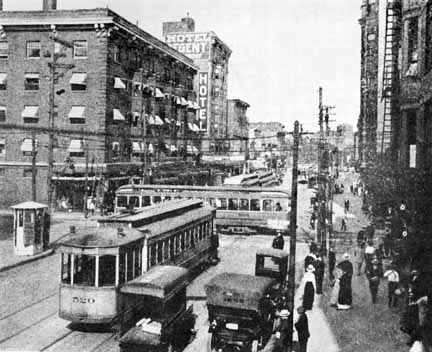
Correct Answer:
In
Cleveland, Ohio on August 5,
1914 at the intersection pictured above,
of 105th
Street and Euclid Ave, the
first traffic signal using electric lights
was put into operation. The
system was built by the American Traffic Signal Co.
and was the first of what would
become a normal and very well accepted part
of the motoring way of life.
You will notice a small booth building on the sidewalk
on the left of the photo.
This was the control center in which a traffic control
officer would sit and manually
switch the lights from red for STOP to green for
PROCEED as traffic flow needed.
There was no yellow warning light as
there are in today's automated
traffic signal systems.
March's
Trivia Challenge winner: Jeremy Johnson -
Buda, TX
Question:
In 1919, which
automobile manufacturer included a camera
and a compass as
part of its list of standard equipment
and for what
vehicle model was this offered?
Correct Answer:
In 1919, the
Templar Touring Roadster
offered a camera by Kodak
and a compass as part of its
standard equipment sold with the car.
July
/
August
/
September
/
October /
November
/
December
/ January
/ February's Trivia Challenge winner:
Barbara Ann Mills - Las Vegas,
NV
Question:
Correctly identify
the year, make, and model of the car pictured below.
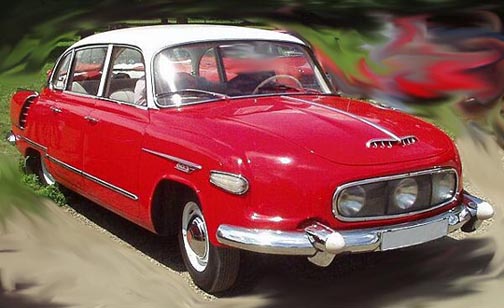
Correct Answer:
The car pictured is a
1958 Tatra model 603 4 door
sedan made in Czechoslovakia.
This has been our
longest Trivia Challenge to date. It took a few months
for us to receive
a correct answer on this one. We received several guesses
that were very
close, in fact had a few that had the vehicle correct but
were slightly off
on the year or the model and so on.
May /
June's
Trivia Challenge winner:
Gabe Rios Jr. - Edinburg, TX
Question:
The 1957 Chevrolet
Bel Air has long been considered the classic American car,
how many various
color combinations were there for the exterior paint
from the factory
for the 1957 Chevrolet Bel Air and what were they?
Correct Answer:
The lacquer paint came in
seventeen colors, sixteen solid choices
and fifteen two-tone
combinations for a total of 31 variations.
There was a staggering 466
model / color varieties. The convertible
was available only in a solid
color, but one of five colors could
be selected for the top. This
represented the greatest color / model
combinations ever offered by
Chevrolet up to this point.
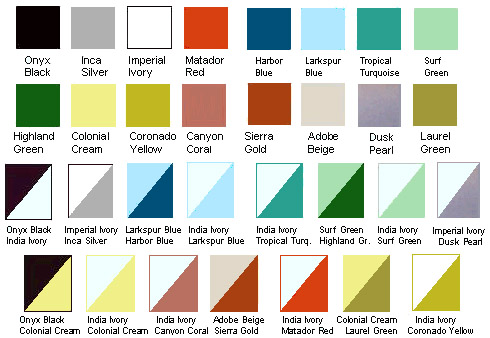
October
/
November
/
December
/
January
/
February
/
March
/
April's Trivia Challenge
winner:
Lance Roth - Redondo Beach, CA
Question:
Correctly identify
the year, make, model
of the vehicle that is pictured
below.
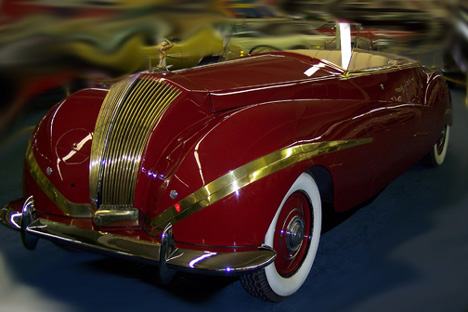
Correct Answer:
It is a
1939 Rolls-Royce
Phantom III Labourdette Drophead.
The car was
originally purchased by Louie
Ritter of New York, who was a successful
furrier to the rich and famous.
He had the car sent overseas to France
and contracted Labourdette to
rework the body of the car and restylize it
to be a unique one of a kind
piece. During the war, the car was still not
completed, so it was hidden away
to help keep anything from happening
to it. It was brought back
out to work on in 1945 and was not completed
until 1946. Louie Ritter did
not take possession of the car until 1947.
The car was listed for sale in
2005 for the sum of $1.5 million.
July
/
August /
September's
Trivia Challenge winner:
George Winget - La
Feria, TX
Question:
Correctly answer
the following question AND give the reason WHY
On the surface of
the moon, which weighs more;
four 1917
Rolliens cabriolets or
eleven 1957
BMW Isetta 2 door coupes?
Correct Answer:
Neither,
neither one exists, they
are not real vehicles.
May
/
June's
Trivia Challenge winner: John Mallinak - Carl
Junction, MO
Question:
Correctly identify
the year, make, model
of the car that is pictured
below.
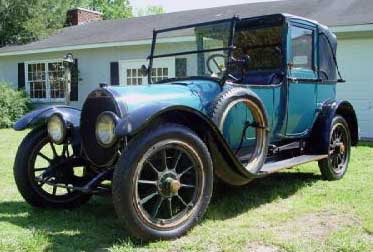
Correct Answer:
It is a 1919
Brewster Town Car.
( Made in the USA )
March
/
April's
Trivia Challenge winner: Jeremy Johnson -
Corpus Christi, TX
Question:
Correctly identify
the year, make, model ,and NICKNAME
of the car that is pictured
below.
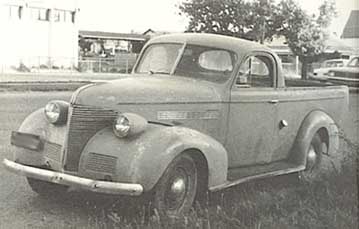
Correct Answer:
It is a
1939 Chevrolet
Coupe Utility, nicknamed the "Ute",
body was created
and made by Holden.
Holden is today a part of the
Chevrolet family located in Australia.
January
/
February's
Trivia Challenge winner: George Winget - La
Feria, TX
Question:
Correctly identify
the year, make, and model of the car
that is pictured
below.
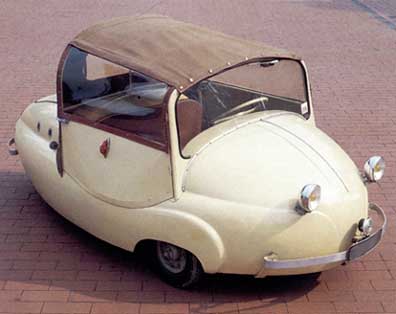
Correct Answer:
It is a
1956
P.
Valle Chantecler
( Made in France )
September
/
October
/
November
/
December's
Trivia Challenge winner:
Gary Petersen - Cresent City,
CA
Question:
Correctly identify
the year, make, and model of the car
that the taillight in this picture
belongs to.
We still do not
yet have a winner, so we have
added a picture of
the front headlight now.
Anyone know the
car?
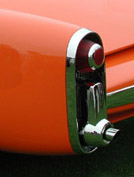
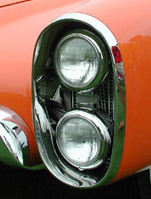
Still need more of
a hint? Here is a shot of the back end of the car.
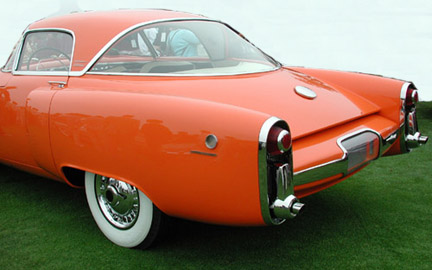
Still can't get it? Here is a shot of the
front side of the car.
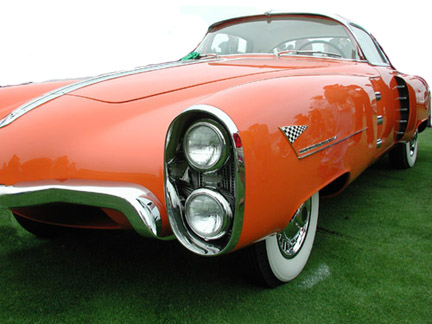
Correct Answer:
It is a
1955 Lincoln Boano
Indy Coupe
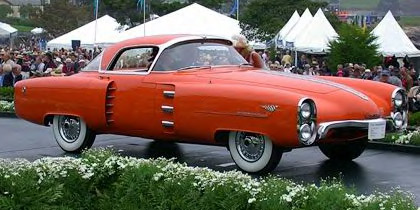
August's
Trivia Challenge winner: Amber Rios - Edinburg, TX
Question:
Correctly identify
the year, make, and model of the car in this picture.
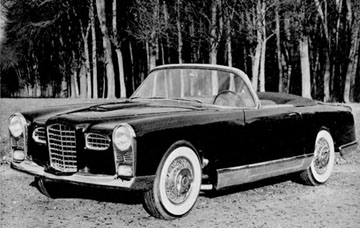
Correct Answer:
It is a
1956 Facel Vega
FV-2 cabriolet
June & July's Trivia Challenge
winner: George Winget - La Feria, TX
Question:
Which American
automotive company found its first home in a three-story,
block-long,
manufacturing plant building which had previously been the
home of the
Corcoran Lamp Co. ?
Hint: The
plant was located at 1145 West Grand Blvd. in Detroit, Michigan
Correct Answer:
Chevrolet
May's Trivia Challenge
winner: Ron Harris - Weslaco, TX
Question:
How many Lincoln
Zephyr Town Sedans were ever produced?
Correct Answer:
47
In 1936, Lincoln Motors released a
fancy, luxury model to its Zephyr line up.
It was called the Town Sedan.
Only 47
Town Sedans were ever
produced. 1936 would be the
only year that the Lincoln Zephyr Town Sedan
would be made. The following
year Lincoln produced a very similar
luxury model Zephyr, however
they renamed it the Town Limousine.
April's
Trivia Challenge winner: Gabe Rios - Edinburg, TX
Question:
Correctly identify
the year and make of this wrecked car?
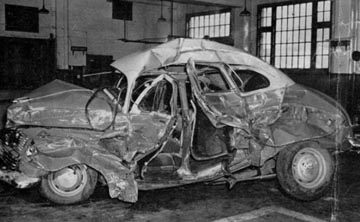
Correct Answer:
This is a
1948 Nash Series "600".
The story behind this photo is
that the Nash is in this condition
because it was struck and
sandwiched between two
streetcars on a road in Winnipeg
Canada.
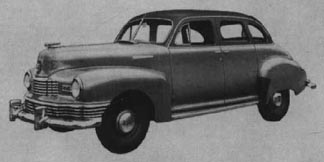
This is what it should have looked
like before the accident.
March's
Trivia Challenge winner: Joe Dale - McAllen, TX
Question:
Correctly identify
the year, make, model of the car pictured below.
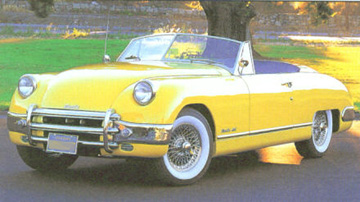
Correct Answer:
This is a
1950 Muntz Jet convertible
February's Trivia
Challenge winner: George Winget - La Feria, TX
Question:
In the year 1948,
which American automobile manufacturing company
produced more
station wagons than any other manufacturer that year?
Correct Answer:
Crosley Motors Incorporated
Crosley
Motors Incorporated
had its main office and engineering facility
in Cincinnati, Ohio and its assembly plants in Richmond, Indiana
(1939-1942) and Marion, Indiana (1946-1952). The Crosley
automobile was the brain child of Powel Crosley Jr., who had
made his fortune as a radio and appliance manufacturer, owner of
the radio station WLW "The Nation's Station" and the Cincinnati
Reds baseball team. The Crosley auto was built ahead of
its time. It was a small, fuel efficient, less expensive
car that was made during a time of big cars and luxury.
Most people didn't think about economy or saving fuel as this
was years before the big fuel crunch of the 1970's hit.
Crosley was the first to implement many ideas on cars, many of
which are still in use today. Crosley was the first to
produce an American car with disc brakes, and all four wheels
were stopped by disc brakes. Crosley was the first to
introduce slab side styling on cars, a styling method that is
still used on most every car produced still today. Crosley
was the first to build a post-WWII sports car. Crosley was
the first to build a Sport Utility Vehicle (SUV), which is one
of the most popular body styles sold today. Crosley was
the first to build an all steel station wagon based on a car
chassis, previous station wagon bodies were fashioned out of
wood. Though Crosley for the most part built low
production numbers of his vehicles each year, in
1948 the
Crosley company built and sold more station wagons
than any other manufacturer. A
total of 23,489 Crosley station wagons were built
that year. Crosley was the first to build a full-bed or
fleet side pick-up truck, previous pick-ups used a step-side
styled bed. Crosley saw the step-side style as having
wasted space that could be used inside the bed area.
Crosley was the first to build an engine that utilized an
overhead cam. Crosley was first to build an engine block
out of stacked layers of tin that were COpper BRAzed together.
The engine was known as the COBRA. (Crosley was also first
car company to use the name Cobra as well as Super Sport)
The engine was built this was to cut down on weight and
manufacturing cost. While the engine was incredibly
successful, it did prove to have a major fault when water would
get between the layers of tin and warp the block and the motor
would be shot. Later in the 1970's General Motors even
tried to revive this idea of a tin engine, but eventually
dropped the idea. Crosley was the first for many other
ideas and inventions as well, many of which were not car related
such as first to place shelves on the doors of refrigerators.
Despite the high production numbers of the 1948 Crosley station
wagon, today it is one of the more uncommonly known vehicles and
one of the most difficult cars to find. They have
certainly become rarer and more scarce.
January's Trivia
Challenge winner: Mark Weber - Beeville, TX
Question:
The Checker Motors Corporation,
known best for its production of the
Checker taxicabs was established
in Kalamazoo, Michigan by a
Russian immigrant named Morris
Markin.
What year was the
Checker Motors Corporation founded?
Correct Answer:
1922
The Checker Motors Corporation,
known best for its production of the Checker taxicabs was
founded in 1922 by a Russian immigrant named Morris
Markin. Checker Motors Corp finds its home in Kalamazoo,
Michigan. After coming to the United States, Markin
purchased the Hadley-Knight chassis manufacturing plant and the
Dort body plant which were converted to build the Checker cars.
The first Checker taxicab rolled off the assembly line in June
of 1923. Through the years, Checker produced several other
models other than taxicabs including limousines, station wagons,
the Landau, and ambulances. During World War II, Checker
made products for other companies in their plants, including
trailers for Sears Roebuck, truck cabs for Ford Motor Co. and
several jeep vehicles for the Army. In 1962, Checker
produced what became their most popular model and most
recognizable Checker, the A-12 Marathon. It was available
in a sedan, deluxe sedan, and a wagon version. The
Marathon proved to be a rugged and very popular automobile that
featured extra wide doors and lots of interior room and became
the standard for taxicabs all over the US. Several large
cities in the US had exclusive contracts with Checker to use
these cars as their municipal taxi service vehicles. The
Marathon remained about the same through the years with very few
changes to the original design or idea. It was built
strong and durable and was powered by a larger engine that would
allow it to move in and out of traffic with ease and with
regular maintenance proved to be a dependable car. In the
1970's as oil prices began to rise, people began buying smaller
more fuel efficient vehicles. The Checker cab only
averaged about 10 miles to the gallon and that just wasn't going
to cut it for many cab companies. Despite their pleading
with Checker to build the cars lighter or with a smaller engine,
Checker refused to change and lower their quality standards and
their sales continued to drop off. Checker produced its
last cab on July 12, 1982, however the Checker company is still
going strong even to this day. While you may have not have
been aware, you probably have seen Checker products in front of
you on a daily basis and didn't know that Checker had anything
to do with it. Today, Checker manufactures many car bodies
and body components for several of the larger auto manufactures,
especially for many General Motors vehicles.
December's Trivia Challenge
winner: Belinda Killinger - Mission, TX
Question:
What year did
the state of Texas first implement the
requirement
that all motor vehicles that operated on public
roads be
registered with the counties?
Correct Answer: 1907
In 1907, Texas House Bill #93
required that all motor vehicles that were used on public roads
had to be registered with their county clerk. The vehicle was
issued a number in the order that it was registered in each
county. The number was to be placed on the vehicle and be at
least six inches in height and displayed "in a conspicuous
place" on the vehicle. Neither the state nor the county issued
actual license plates during the first years. Often,
motorists either painted the numbers on the vehicle itself, or
fashioned a number plate by attaching numbers to a piece of wood
or leather and hanging that from their vehicle. Vehicle
registration went into affect on August 10,
1907. The first Texas
license number that was recorded for registry was issued to a
bus that was owned by W.B. Chenoweth of Colorado City, TX.
November's Trivia Challenge
winner: Pat Harris - Weslaco, TX
Question:
The Studebaker manufacturing company
began as a blacksmith
shop which would later produce
horse drawn wagons and
became the world's largest wagon
manufacturer at its time.
When Studebaker first produced an
automobile, it was an
electric car. Their gasoline
powered automobile came a
couple years after their first
production electric car.
From what year
AND
until what
year did the Studebaker
company produce and sell
gasoline powered automobiles?
Correct Answer:
1904 &
1966
The Studebaker Story
The H & C
Studebaker blacksmith shop opened in 1852 at the corner of
Michigan and Jefferson Streets in what is now the heart of
downtown South Bend, Indiana. Henry and Clement Studebaker's
blacksmith shop would turn into the Studebaker Manufacturing
Company in 1868, and would eventually become the largest wagon
manufacturer in the world. Studebaker would also be the only
manufacturer to successfully switch from horse-drawn to gasoline
powered vehicles. John Mohler Studebaker returned from
California in 1858 where he made wheelbarrows for gold miners,
and invested his earnings in the business. At this time, the
brothers were filling wagon orders for the U.S. Army, and would
continue to do so throughout the Civil War. By 1887, sales
would eclipse two million dollars, and by 1885, production would
top 75,000. Studebaker eased their way into the automobile
market after the turn of the century, introducing an electric
car in 1902. Gasoline-powered Studebakers came in
1904, produced by the
Garford Company in Ohio, marketed under the name Studebaker-Garford.
In 1911, Studebaker would join forces with
Everitt-Metzker-Flanders Company of Detroit to form the
Studebaker Corporation. Studebaker sold automobiles under the
EMF and Flanders names until 1913; from thereafter, all new cars
carried the Studebaker name. Studebaker was still producing
wagons, and would do so until 1920, at which time automobile
production was moved from Detroit to South Bend. During this
time, Studebaker built automobiles in the medium-price-field.
In 1927, Studebaker introduced the Erskine; a small car designed
for the European market, and purchased luxury automaker
Pierce-Arrow. The Great Depression, combined with questionable
management decisions lead to Studebaker going into receivership
in 1933. They would emerge from receivership under Studebaker
Vice-Presidents Paul Hoffman and Harold Vance. Raymond Loewy's
relationship with Studebaker began in 1936. Raymond Loewy
Associates held the Studebaker account from 1936-1955, with the
first RLA designs being the 1938 models. RLA would also style
the successful 1939 Champion, which marked Studebaker's first
successful foray into the low-priced field. Defense
contracts during World War II had Studebaker building B-17
Flying Fortress engines, US6 6x6 military trucks, and the M29
and M29C "Weasel". Having produced military trucks during
WWII, Studebaker was able to resume civilian truck production
quickly. M-Series trucks, introduced for 1941, would continue
through 1948. The 2R series debuted for 1949 and was an
immediate hit. The Transtar appeared for 1956, and the
Lark-based Champ came in 1960. New styling marked
Studebaker's return to automobile production after WWII. While
all prewar manufacturers resumed production with warmed-over
prewar models, Studebaker introduced new styling for the 1947
model year, highlighted by the wraparound rear-windowed
Starlight Coupe. The 1950 models introduced the famous "bullet
nose" styling, while 1951 marked the introduction of the
Studebaker V8. The "Loewy Coupes" came in 1953. Styled
by RLA Design Chief Bob Bourke, these automobiles would evolve
into the 1955 Speedster and finally into the 1956-1964 Hawk
line. Due to a number of factors, Studebaker's finances were
poor by 1954, leading to a merger with Packard.
Studebaker-Packard would fare no better, as Studebaker would
lose 43 million dollars in 1956, and Packard disappeared
altogether after 1958. Studebaker would rebound in 1959,
introducing the compact Lark. Much like the Champion of 20
years earlier, the Lark was a success, pushing Studebaker back
into the black. By 1961, however, Studebaker would be back in
the loss column. They countered with the new Gran Turismo Hawk
for the 1962 model year, styled by Brooks Stevens. The
Studebaker Avanti debuted as a 1963 model. Styled under Raymond
Loewy, the Avanti featured disc brakes, optional supercharged
engines, and a fiberglass body. Studebaker's financial problems
continued, however. In December 1963, Studebaker closed its
South Bend plant. Production continued through March 1966 at
the Hamilton, Ontario, Canada plant, where a blue and white
1966 Cruiser marked the end of
114 years of Studebaker vehicle production.
Rules: The first person to email us with the
correct answer to the trivia
challenge question
for that month will receive a prize. The person who wins
the trivia
challenge will NOT
be eligible to win the trivia challenge for the
following month.
They will have to sit out the following month in order to give
someone else
an opportunity to win. Your answers should be emailed to
us
at: RGVOldCars@aol.com Correct
answers to the questions will be posted
once we have
received a correct answer and confirmed a winner.
All decisions made
by RGV OldCars.com officiating contest
judges on answers,
facts, and discrepancies are final.
Back
to Top

Some trust in chariots and some
in horses,
but we trust in the name of the
Lord our God. - Psalm 20:7
All images
and content contained on site copyrighted
copyright
©
2000, - 2025 RGV OldCars and RGV OldCars.com All rights
reserved
|

